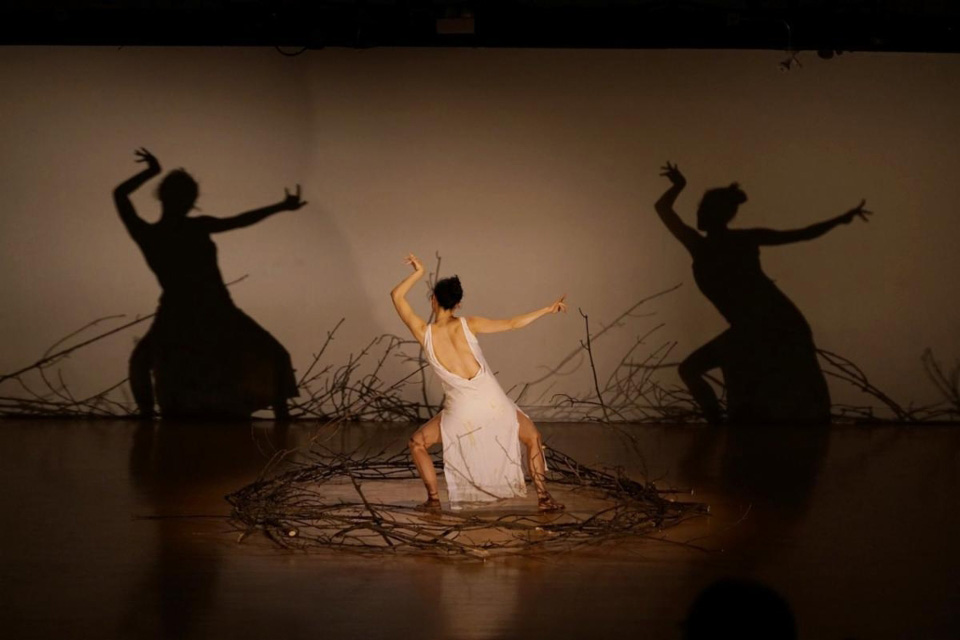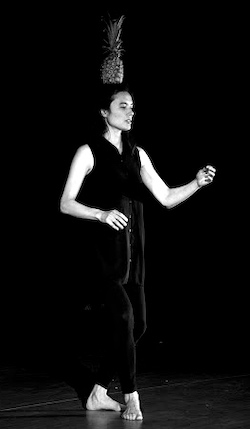From KabukTheaters and Shinto Shrines, Mitsu, Salmon Brings Butoh to Brandeis

Faculty Stories
Assistant professor of theater arts Mitsu Salmon creates original performance and visual works that fuse multiple disciplines, but she has a special connection to butoh.
She has taught the unique Japanese dance-theater in workshops nationally and internationally in places, such as Japan, Taiwan, and Los Angeles, and was a member of the butoh company, Ima Tenko and Kiraza, in Kyoto from 2008-10.
Salmon joined the Brandeis faculty this fall, and in the spring she will be teaching a theater arts course on butoh: THA 122b.
Salmon took some time to talk about butoh with BrandeisNow:
Can you tell me about the butoh course you are teaching this spring?
Butoh began in 1960s Japan as a new dance-theater form developed by Tatsumi Hijikata and Kazuo Ohno and has since become a global phenomenon. My course draws from butoh training through guided imagery, movement and structured improvisation. The exercises pull from nature, the mythical and the unconscious as sources of inspiration. As well as studying the practice of butoh, students will also learn about the art form's cultural, historical and philosophical aspects. The course will be a mixture of movement and performance exercises as well as weekly readings and discussions.
What is the history of butoh?
Butoh emerged in the 1950s and '60s in Japan after WWII during the post-war shock. It has the push and pull between hanging on to traditional Japanese culture and also wanting to reject many of its beliefs and customs. It is a dance form that is difficult to define because it is not a method but rather a philosophy, aesthetic and lineage. At the time of its founding, the dance form was quite taboo in many ways. For example, dancers would perform in the nude or address queerness in the work. There was a sense of being provocative and counterculture, yet at the same time drawing from and honoring traditional roots. For example, butoh, like traditional Japanese dance forms, often has movements low to the ground developed because of Japan's reliance on rice farming.
What was your education path?
 Salmon performs with a pineapple on her head at the 2015 Post Butoh Festival in Chicago
Salmon performs with a pineapple on her head at the 2015 Post Butoh Festival in Chicago
My undergrad studies were in experimental and physical theater at NYU, and I received my MFA in performance from the School of the Art Institute of Chicago. In the New York Theater training, a huge base is Grotowski. I found a lot of parallels between physical theater training and butoh. Primarily the connection between movement and imagery, emotions and storytelling. When I got to Berlin, where I lived for a little bit, butoh was very popular. I was drawn to exploring this connection between dance and performance. Butoh, like my experimental theater training, emphasized the embodied interior world as well as transformation. But with butoh, it became more fantastical such as exploring, hoping like a horse or becoming a raindrop.
What is your connection to Japan and butoh?
I was born in Los Angeles, but my mother was born in Tokyo, Japan. I did not grow up speaking Japanese because of the lingering racism after the war. A teacher told my grandparents not to speak Japanese at home to their own children. So my mother, unfortunately, lost a lot of the language. As an adult, I moved to and lived in Japan, Kyoto, for three years to learn the language, get immersed in the culture and also study. There I trained in butoh with a teacher Ima Tenko, and after a year, she asked me to join her company. Through being in her company, I learned a lot about Japanese culture, histor, and language. We mostly rehearsed in Japanese, and the pieces often drew from art, philosophy and stories of Japanese culture. We also worked very communally, cooking, eating and cleaning together as well. All of those aspects are things I want to share in the butoh class this spring.
What were some of the butoh performances like?
We would perform in galleries, old Kabuki theaters, Shinto shrines and contemporary dance spaces. The work was very visual and fantastical. For example, in one dance, I became a pomegranate, in another a mermaid, as well as other mythical creatures.
In butoh, where you are embodying a pomegranate or a mythical creature, transformation seems to be essential.
Transformation is a big part of the dance form. The founders, Tatsumi Hijikata and Kazuo Ohno, however, approached it in different ways. Ohno explored butoh in a very spiritual way — the life of a flower growing and dying, the sense of experiencing empathy or oneness through that. Hijikata was interested in wildness and unbridled imagination. Hijikata's choreography was very surreal. He was influenced by the surrealists and the unconscious. My teacher, Ima Tenko, was very interested in preserving, but also contemporizing Japanese myth and storytelling. There really is no single answer. There are so many different reasons.
It sounds like you were drawn to all of this because it continued your training in the United States with Grotowski training that connected imagery to movement. You wove that training together with your own family history, exploring that further by spending time in Japan, learning the language and culture. How has it influenced your work?
My work is highly influenced by butoh in terms of how I use it in the process of creating as well as ideas. However, I would not say my work is butoh. For example, I differ in aspects of butoh's aesthetic, such as I don't paint myself white, and my movement vocabulary diverges in that I also combine my theater and contemporary dance practice into my work. Rather I would say I am an interdisciplinary artist who incorporates elements of butoh. For example, butoh often draws from ancestors, animals and creatures, things that are non-human, and plants. All of these are vibrant sources in my work for generating movement. Recently I developed a work about orchids. Orchids' growth patterns inspired the choreography, and I also tied it to my own family history. I am also interested in mythical creatures in my practice and teaching.
Mythical creatures from where?
Mythical creatures can be from folklore or people can make up their own mythical creatures.
Can a person take the same ideas around folklore and apply it to their own personal culture?
Yes, absolutely. I have taught mostly workshops where I introduce the ideas of butoh. I may show a book on Japanese mythical creatures, but I also encourage people to pull from their own culture or make something totally new. It is a combination of introducing aspects of Japanese culture, but it is also a very popular dance form around the world, in Europe and the U.S. I am interested in how butoh can adapt to different cultural references.
It is connecting to something that is deep and collective it seems. More symbolic. One finds their way in through emotion and a sense of oneness. How do you think that relates specifically to where we find ourselves today given the pandemic?
The pandemic made people really crave connection and community. With butoh, there is a huge sense of community. The butoh company I worked with, we would have tea and eat together. There is a sense of openness and working with the unconsciousness. It is a way of learning about another culture but making it applicable to your own. With my class, each week there is a different themes connected to butoh, and much of the class is movement-based. One week we might explore ancestors, one week might be nature. It is a physical discipline but there is history and philosophy mixed in, too. A typical class might begin with a little discussion about the reading assigned that week, but then we get into the movement and explore those ideas. We may go outside and think about that somatically if we are focusing on nature, and then we come back into the classroom and discuss how the reading connects with the movement. How does it feel to integrate the movement? There is consistency where we begin each class with a warm-up we learn together taken from my training.
It seems like what you are talking about is very accessible, that anyone can find a way in. Everyone is drawing from their own personal experiences and culture as well. It is a universal artform that allows for change?
Butoh is a dance form rooted in Japan, connected to its complex history, and at the same time, it has international significance. For example many practitioners are now based out of Europe. There is a company in Sweden and another one in Mexico. It has become a global phenomenon. I do feel it is important to acknowledge that it comes from Japan, but it is a dance form that you can draw from your own unconscious, your own experience, it is applicable in that way. It does have that openness. I use it in my own practice in a very flexible way. The form came out of a sense of rebellion and exploration, and that sense of inquiry and play are essential to the form.
So, that still exists and persists, that exploration?
Yes. It emerged in the 1950s and '60s, as experimental, trying to figure out things.
It is still asking, "How do we hold our culture, how do we modernize?"
There is a sense of protest, too. At the time, there was a sense of questioning the status quo, but also honoring traditions. I am very interested in family and traditions, but I am also questioning and fragmenting and taking apart all those things in my work. With butoh, I can have a sense of traditions but also a welcoming to break them apart.